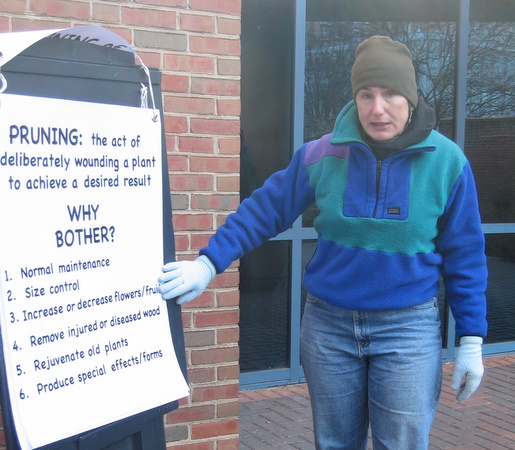Notes from a Winter Pruning Workshop

I traveled to Arlington, VA last weekend for the winter pruning instruction given by Kirsten Conrad Buhls, Extension Agent, and her well-trained Tree Stewards. It was kinda cold for note-taking, but thankfully there were hand-outs.

Pruning Tips

Teachers of pruning always tell us to have a reason to make any cut – like the ones listed above, although.
Kirsten talked a lot about rejuvenation pruning, which is sooo needed by sooo many plants, yet so seldom done. She explained that new growth happens where we make the cut, which is why we should generally avoid making cuts at the outer edges of the plant.
Instead, we can reduce the size and generate new growth from the center of the plant by removing whole branches all the way to their origin. For most plants it’s best (and always safest) to remove no more than one-third of the plant at a time. So for large overgrown, underperforming shrubs, remove one-third of the stems each year over three years, for a totally new plant that’s much more vigorous.
Another important pruning tip we learned is to cut just above a node or branch, about 1/4 to 1/2 inch away. That way, unsightly, unproductive stumps aren’t left hanging, and cuts are made where they can generate the most new growth – at those nodes where the growth hormones are.
Kirsten also suggested that for plants that are sheared, to then go back with hand pruner to “punch holes” in the outer edge of the plant. By removing small clumps where the shrub is thickest, air, light and water are allowed to reach the interior of the shrub, thus stimulating growth there. Click here for more tips about using this technique on boxwoods, from the experts at the National Arboretum.
More good pruning tips from the experts: the Morton Arboretum, Colorado State, and the University of Georgia.
Shrubs to Prune in Winter (November through February)
Abelia, Arborvitae, Beautyberry, Boxwood (through July is fine), Butterfly Bush, Chastetree, Cherrylaurel, Clethra (Summersweet), Cotoneaster (both evergreen and deciduous), Crape Myrtle, Redtwig Dogwood, Thorny Eleagnus, Euonymus (evergreen and deciduous), Gardenia, Hibiscus, summer-blooming Hydrangea, St. Johnswort, Juniper, Nandina, Osmanthus, Photinia, Mugo Pine, Privet (both evergreen and deciduous), Smoke Tree, summer blooming Spirea, Sumac, and Yew.
Posted by Susan Harris.

This Post Has 0 Comments